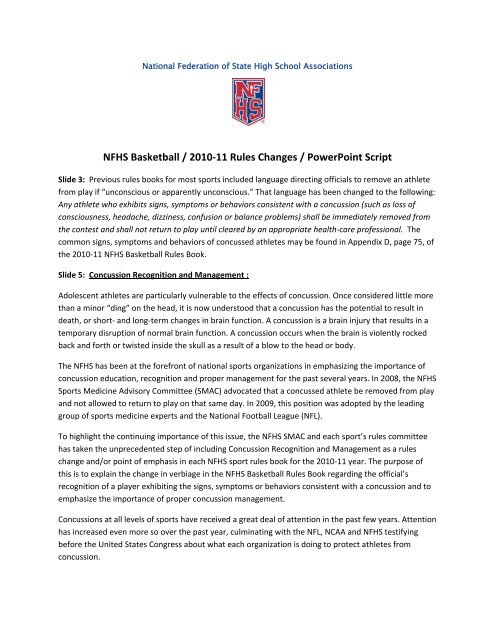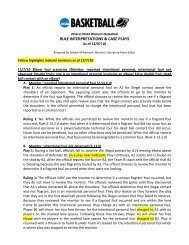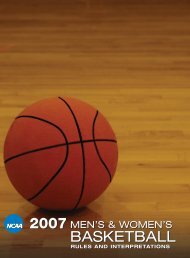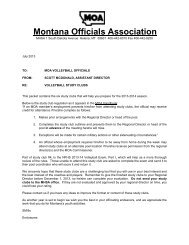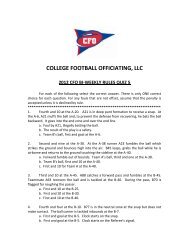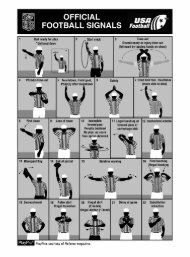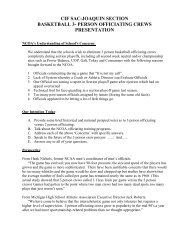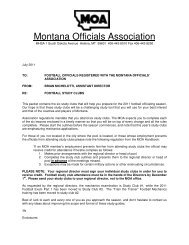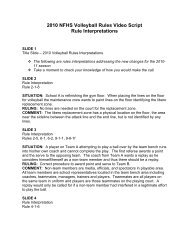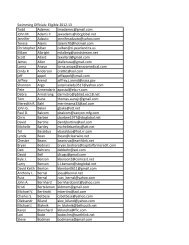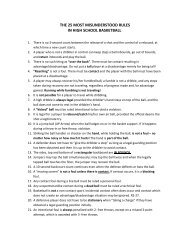NFHS Basketball / 2010-11 Rules Changes ... - OSAA Basketball
NFHS Basketball / 2010-11 Rules Changes ... - OSAA Basketball
NFHS Basketball / 2010-11 Rules Changes ... - OSAA Basketball
You also want an ePaper? Increase the reach of your titles
YUMPU automatically turns print PDFs into web optimized ePapers that Google loves.
National Federation of State High School Associations<strong>NFHS</strong> <strong>Basketball</strong> / <strong>2010</strong>‐<strong>11</strong> <strong>Rules</strong> <strong>Changes</strong> / PowerPoint ScriptSlide 3: Previous rules books for most sports included language directing officials to remove an athletefrom play if “unconscious or apparently unconscious.” That language has been changed to the following:Any athlete who exhibits signs, symptoms or behaviors consistent with a concussion (such as loss ofconsciousness, headache, dizziness, confusion or balance problems) shall be immediately removed fromthe contest and shall not return to play until cleared by an appropriate health‐care professional. Thecommon signs, symptoms and behaviors of concussed athletes may be found in Appendix D, page 75, ofthe <strong>2010</strong>‐<strong>11</strong> <strong>NFHS</strong> <strong>Basketball</strong> <strong>Rules</strong> Book.Slide 5: Concussion Recognition and Management :Adolescent athletes are particularly vulnerable to the effects of concussion. Once considered little morethan a minor “ding” on the head, it is now understood that a concussion has the potential to result indeath, or short‐ and long‐term changes in brain function. A concussion is a brain injury that results in atemporary disruption of normal brain function. A concussion occurs when the brain is violently rockedback and forth or twisted inside the skull as a result of a blow to the head or body.The <strong>NFHS</strong> has been at the forefront of national sports organizations in emphasizing the importance ofconcussion education, recognition and proper management for the past several years. In 2008, the <strong>NFHS</strong>Sports Medicine Advisory Committee (SMAC) advocated that a concussed athlete be removed from playand not allowed to return to play on that same day. In 2009, this position was adopted by the leadinggroup of sports medicine experts and the National Football League (NFL).To highlight the continuing importance of this issue, the <strong>NFHS</strong> SMAC and each sport’s rules committeehas taken the unprecedented step of including Concussion Recognition and Management as a ruleschange and/or point of emphasis in each <strong>NFHS</strong> sport rules book for the <strong>2010</strong>‐<strong>11</strong> year. The purpose ofthis is to explain the change in verbiage in the <strong>NFHS</strong> <strong>Basketball</strong> <strong>Rules</strong> Book regarding the official’srecognition of a player exhibiting the signs, symptoms or behaviors consistent with a concussion and toemphasize the importance of proper concussion management.Concussions at all levels of sports have received a great deal of attention in the past few years. Attentionhas increased even more so over the past year, culminating with the NFL, NCAA and <strong>NFHS</strong> testifyingbefore the United States Congress about what each organization is doing to protect athletes fromconcussion.
Given that most concussed athletes do not lose consciousness, yet they often show other commonsigns, symptoms and behaviors of concussion, the <strong>NFHS</strong> SMAC strongly believes that officials must beempowered to remove these athletes from play, thus protecting them from potential further injury.Continued participation in any sport following a concussion can lead to worsening concussionsymptoms, as well as increased risk for further injury to the brain, and even death.Slide 6: Concussion Recognition and Management (continued):Neither officials, nor coaches, are expected to “diagnose” a concussion; that is the job of an appropriatehealth‐care professional. The previous rule called upon officials to determine “apparently unconscious”which appeared to expect some level of medical judgment. Officials are now being asked to use theirbest judgment again in observing the signs, symptoms and behaviors, but are no longer being asked tomake what could be perceived to be a medical opinion. The well‐being of the athlete is of paramountconcern during any athletic contest. Officials, coaches and administrators are being asked to make allefforts to ensure that concussed athletes do not continue to participate. Early recognition of concussionand removal of the injured athlete from activity (game or practice) is a shared responsibility. Thus,coaches, players and administrators should also be looking for signs of concussion in all athletes andshould immediately remove any suspected concussed athlete from play.Slide 7: Concussion Recognition and Management (continued):The game official is not responsible for the evaluation or management of the athlete after he/she isremoved from play. The responsibility of further evaluating and managing the symptomatic athlete fallsupon the head coach, appropriate health‐care professional or other individual designated by schooladministrators. If an appropriate health‐care professional determines that the athlete HAS NOT suffereda concussion, the athlete may return to play.An “appropriate health‐care professional” must be determined by each member state associationand/or school district with respect to state laws and local preferences. Such individuals should beknowledgeable in the evaluation and management of sports‐related concussions and may, dependingon controlling law, include MDs, DOs and certified athletic trainers.Slide 8: Concussion Recognition and Management (continued):If there is no appropriate health‐care professional available to evaluate the athlete, the athlete SHOULDNOT be permitted by the coach to return to play. Please see the “<strong>NFHS</strong> Suggested Guidelines forManagement of Concussion in Sports” at www.nfhs.org for further information on sidelinemanagement.The official does not need written permission for an athlete to return nor does the official need to verifythe credentials of the appropriate health‐care professional. Ensuring compliance with the SuggestedManagement Guidelines is a health and safety issue and should be the responsibility of the head coachand school administration, NOT the game official.Slide 9: Suggested Concussion Management:
The suggested guidelines for concussion management fall outside the realm of game management, butare clearly a health and safety issue for coaches and administrators. These guidelines should also beapplied to practices and scrimmages. The position of the <strong>NFHS</strong> SMAC is that no athlete should return toplay or practice on that same day after suffering a concussion. Studies have shown medical professionalsthat the school‐aged brain does not recover quickly enough for a high school athlete to return to activityin such a short time.Athletes with continued concussion symptoms are at significant risk for recurrent, cumulative and evencatastrophic consequences of a second concussive injury. Such risks are minimized if the athlete isallowed time to recover from the concussion and return to play decisions are carefully made. No athleteshould return‐to‐sport or other at‐risk participation when symptoms of concussion are present andrecovery is ongoing.Slide 10: For further details, please see the “<strong>NFHS</strong> Suggested Guidelines for Management of Concussionin Sports” at www.nfhs.org.Slide <strong>11</strong>: 2.8.5 SITUATION: A1 and B1 hit heads in diving for a loose ball and both appear injured.However, A1 is immediately removed from the game by the officials as he/she is exhibiting signsconsistent with a concussion. Later in the game, A1 reports to the scorer’s table to reenter the contest.Ruling: The rules permit A1 to return to the game once he/she has been cleared by an appropriatehealth‐care professional. The responsibility for obtaining that clearance rests with the coach/school, andneed not be verified by the officials (unless state procedures require verification). If A1 appears at thescorer’s table to reenter the game, the officials shall assume the coach/school followed the appropriatereturn‐to‐play procedures and A1 is eligible to participate.Slide 12: The rule was changed to give the student‐athletes more color options for head/wristbands.The committee felt that provided it was a school color and all team members wore the same color, itdidn’t have to be the same color as the torso. All head/wristbands must still be a single solid color.Slide 14: 3.5.3 SITUATION: Team A’s school colors are blue and gold and the predominate color ofTeam A’s jerseys are white. Prior to the game, an official notices that several Team A members arewearing (a) blue headbands and blue wristbands; and (b) beige pre‐wrap around the entire head andblue wristbands. RULING: Legal in (a). Illegal equipment in (b); the headband color does not match thewristband color. The official shall inform the player and the head coach that these items are illegal andmay not be worn during the game.Slide 15: In 2005, the rules were changed to penalize a player leaving the court for an unauthorizedreason from a technical foul to a violation. The committee’s focus at that time was the live‐action playwhere a player extended the playing court by going out of bounds (perhaps to go around a screen) andreturned to the playing court in another location (perhaps a more advantageous position). That rulesmodification remains a positive change; however, it created a gap in the rule when the act was by aplayer, while during a dead‐ball situation, left the court for an unauthorized reason to demonstrateinappropriate or unsporting behaviors. Therefore, a new rule was added, very similar to the rule prior to2005, but specifically relating to the demonstration of resentment, disgust or intimidation.
Slide 16: 10.3.6 SITUATION: With 4 minutes remaining in the second quarter, B1 commits his/her thirdfoul against airborne shooter A1; the try is unsuccessful. Team B’s coach immediately sends B6 to thescorer’s table to replace B1 after A1’s first free‐throw. B1’s replacement may not enter the game untilafter A1’s first free throw. B1, disgusted with the official’s call and realizing he/she will soon leave thegame, goes and sits on the end of Team B’s bench just after the official reports the foul. RULING: B1 isassessed an unsporting technical foul for leaving the court for an unauthorized reason to demonstratedisgust. A1 will attempt the two shooting‐foul free throws followed by any Team A member attemptingthe two free throws for the technical foul. (10‐3‐6i; 3‐3‐2)10.5.5 SITUATION A: Airborne shooter A1 is fouled by B1 after the ball is released on the try. Playingtime for the second quarter expires while the unsuccessful try is in flight. Since no players are requiredto line up for the free throws, Team B’s head coach takes the team to the locker room to begin theintermission. RULING: Team B’s head coach is assessed a direct technical foul for permitting teammembers to leave the bench/court for an unauthorized reason. Even though no time remains on thegame clock, the quarter doesn’t end until A1’s free throws are completed; therefore, the technical foulis part of the second quarter. A1 will attempt the two shooting‐foul free throws followed by any Team Amember attempting the two free throws for the technical foul. The third quarter will begin with thealternating‐possession procedure. (5‐6‐2 Exception 3)Slide 17: While the committee was addressing the individual actions of a player, it also addressedsimilar actions by an entire team or bench personnel. The new rule gives specific rule backing forassessing a technical foul when a team or bench personnel is not at the team bench area while the gameis in progress.Slide 18: 10.5.5 SITUATION B: A spectator heckles Team A member, A9, while he/she is sitting on TeamA’s bench. A9 leaves the bench area and goes into the stands to confront the fan. RULING: Team A’shead coach is assessed a direct technical foul for permitting A9 to leave the bench area for anunauthorized reason. Team B is awarded two free throws and the ball for a division line throw‐in.


